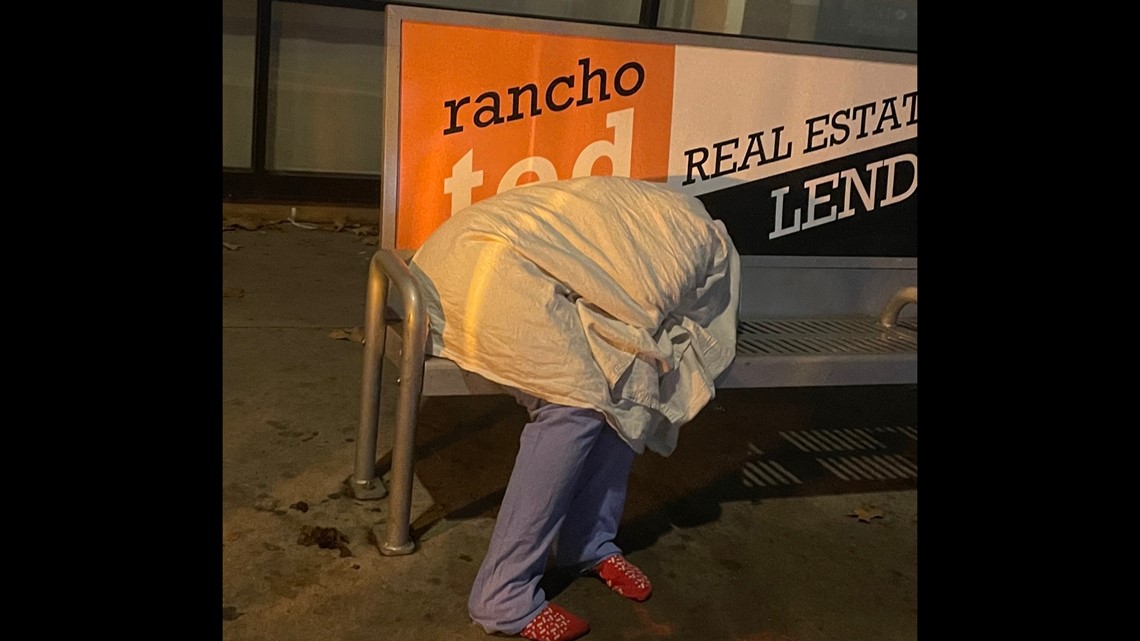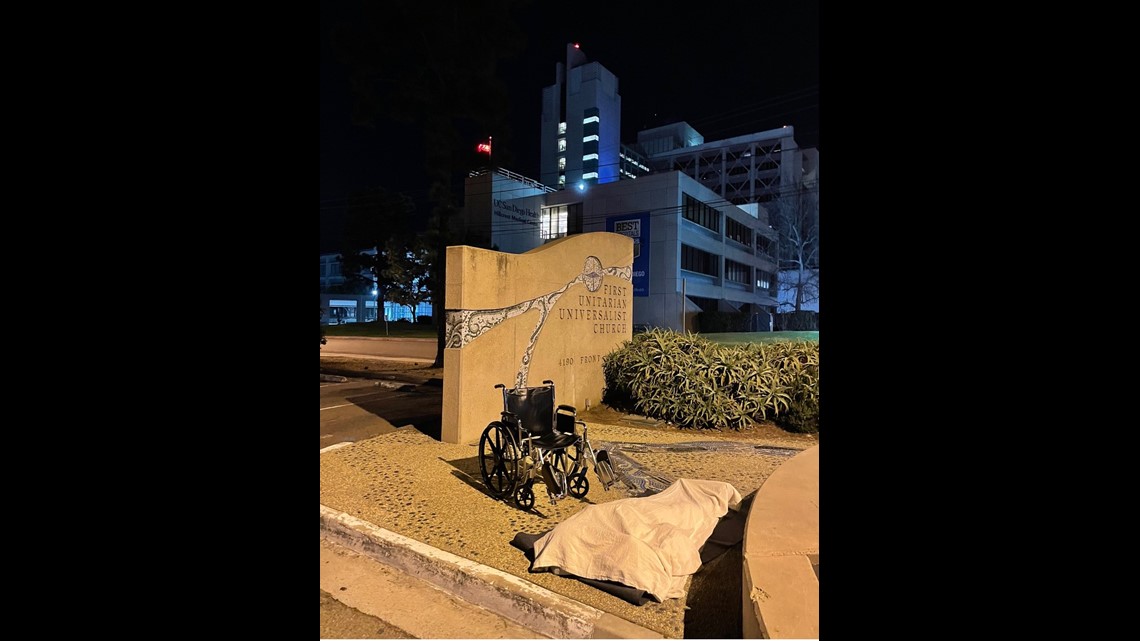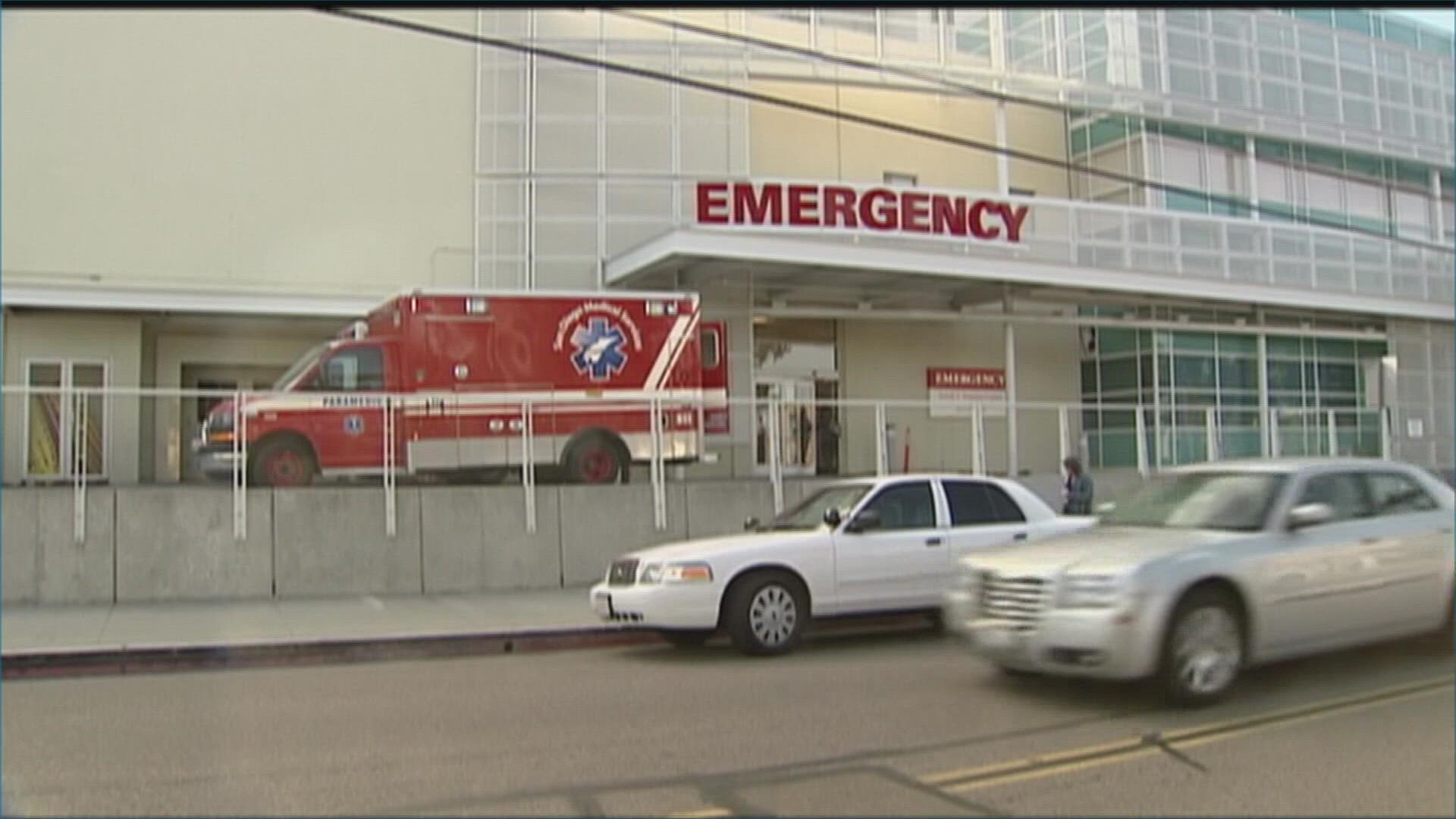SAN DIEGO — Heading west on Washington Street toward her new job as a nurse technician at Scripps Mercy Hospital, "Christine" spotted a man slouched over in a wheelchair in a parking lot near the intersection of 3rd Avenue and Washington Street. Judging by the man's posture and because he was dressed in a hospital gown with a hospital bag next to him, she knew something was wrong.
She pulled her car over and approached the man.
"I immediately called 911 and started to do CPR, I could tell as I got closer that he was dead."
Added the former nurse technician, "It's upsetting, so many people drove by him that day. They could have helped him, maybe saved him from dying. But people were probably like oh he's homeless and probably just drunk, or on drugs. It's just another unsheltered person, it speaks to the collective attitude of society."
Christine, who wishes to stay anonymous, is now speaking out about how some homeless patients at Scripps Mercy and San Diego's urban hospitals are treated and the frequency that many are rushed out of hospital emergency rooms, often with no place to go, no shelter to stay at, and no plans for care.
Allegations of 'patient dumping'
Her testimony comes as San Diego's City Attorney is pursuing a lawsuit against Scripps Health for allegedly dumping homeless patients on the streets without basic care or a treatment plan.
In that lawsuit, the city says Scripps staff discharged a man from the hospital who could not care for himself. Investigators later found the man unresponsive and barely coherent at an independent living facility.
The allegations in the lawsuit are no surprise for the former nurse tech at Scripps, Christine.
During her nearly two years of working at Scripps, Christine says seeing homeless patients ushered out of the hospital and onto Fifth Avenue was a regular occurrence.
"We would just discharge them to Fifth Avenue in Hillcrest. They weren't given a bus pass or a taxi ride back to wherever they stay, where they sleep at night. They were left without support. Security guards would make sure they don't stay on the campus and act as a barrier for them coming back."
Christine says she saw homeless people walking in their hospital gowns around Hillcrest and Mission Hills on a regular basis.


Now, the former nurse technician says she wants to see change.It should begin from the top down.
"There's a lot of dehumanizing. It's in stark contrast to how a patient who maybe doesn't appear unsheltered," said Christine. "The care that they receive is different. There's a general consensus that these people just don't really deserve care, you know that that's not really an emergency. They're just there, you know, to kind of hang out, I guess."
Added Christine, "From a medical standpoint, if you are providing care to somebody, and you're aware that they're not going to receive the care that you intend for them to receive, that's a form of like abandonment of care."
Christine says hospital executives at Scripps and other hospitals that treat a high number of homeless patients need to ensure proper training for all staff. Hospitals, she said, need to give more resources to the social workers who oversee discharging patients.
"The resources just aren't there for staff and administrators and the board of directors needs to make sure they are," she says. "The general attitude is that this patient population is something that needs to be dealt with, not people to be supported or helped. At the end of the day, that attitude is harmful."
Response from Scripps
Scripps, denies the allegations that the hospital treats homeless patients different and dumps them out onto the streets without a plan or support.
A spokesperson for Scripps Health says it "has not received any complaints from patients regarding our hospital discharge process, which complies with state law, regulations and local requirements."
Furthermore, "Scripps gives homeless patients weather-appropriate clothing as needed, feeds them a meal, provides them with their prescriptions and/or medication, screens them for infectious diseases, and offers them any necessary vaccinations. We ensure they are safe to leave the hospital and work with them to develop a discharge plan, which includes giving them discharge instructions, follow-up for medical or behavioral health care needs, and providing them with information and access to community resources so they can access food, clothing, and shelter."
Added the spokesperson, "It’s important to note that homeless shelters do not accept newly homeless patients directly from hospitals; they must be assessed and established by specific community agencies.
The Scripps spokesperson says the hospital provides bus passes or taxi vouchers and makes sure they are given options upon discharge.
"They have a right to self-determination and can accept or decline the resources offered," said the spokesperson. "We’re proud of the tireless efforts by our dedicated staff in helping patients address what can be very challenging situations in the hospital discharge process. We have no reason to believe there has been any deviation in our adherence to our discharge process."
The Larger Problem
Some homeless people and homeless advocates say the problem is not exclusive to Scripps but is a regional issue but is happening at hospitals throughout the county, including a few blocks away from Scripps Mercy at UC San Diego Medical Center.


Aaron Mellon was homeless for 10 years before finding housing in March. Mellon says he spent most of his time in Hillcrest and Mission Hills while living on the streets and was discharged from UC San Diego Medical Center without shoes on his feet.
"They were shooing me away," Mellon told CBS 8. "I had a piece of gauze and a bandage on my leg, totally barefoot. It's like people are trying to get help and they're totally denied."
As for the same allegations against UCSD, a spokesperson said that "safety is a priority for all patients at the time of discharge. I can confirm for you that our current process is that patients who are experiencing homelessness are, at a minimum, provided with a list of shelters and, if needed, means of transportation to arrive there."
Homeless advocate Amie Zamudio often drives the area around the two hospitals and she says she sees homeless people still wearing hospital garb on a regular basis.
"It happens on a daily basis and it is a systemic failure that is seen at hospitals throughout the city and county. Every hospital does this," says Zamudio. "I have walked patients who get out of one hospital straight to another hospital."
Meanwhile, the city says it is working hard to make sure that those without homes have shelters available to them. A spokesperson for the city also said that hospitals are responsible for making sure that discharge plans are in place.
"It is the responsibility of the hospitals to create a discharge plan that is appropriate for each person’s care needs," the spokesperson told CBS 8. "The City of San Diego has worked over the past year to create more shelter options for those with specific and higher needs and continues to advocate for more recuperative care options across the County. The City stands ready to assist hospitals as they develop strategies for improving how individuals experiencing homelessness are released following medical care at one of San Diego’s hospitals."
Zamudio disagrees.
"The city is failing. It is talk without action," said Zamudio. "I ask anyone to go and try to find out about recuperative care beds and how easy that is to get into. It's far from easy and far from available. I know. I am the one searching for places for medically compromised people to go. It is all talk."
WATCH RELATED: San Diego hospital accused of 'patient dumping'
WATCH RELATED: San Diego non-profit puts elderly patients into hotel rooms

